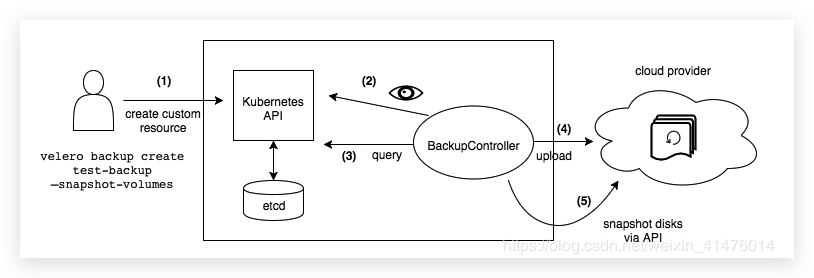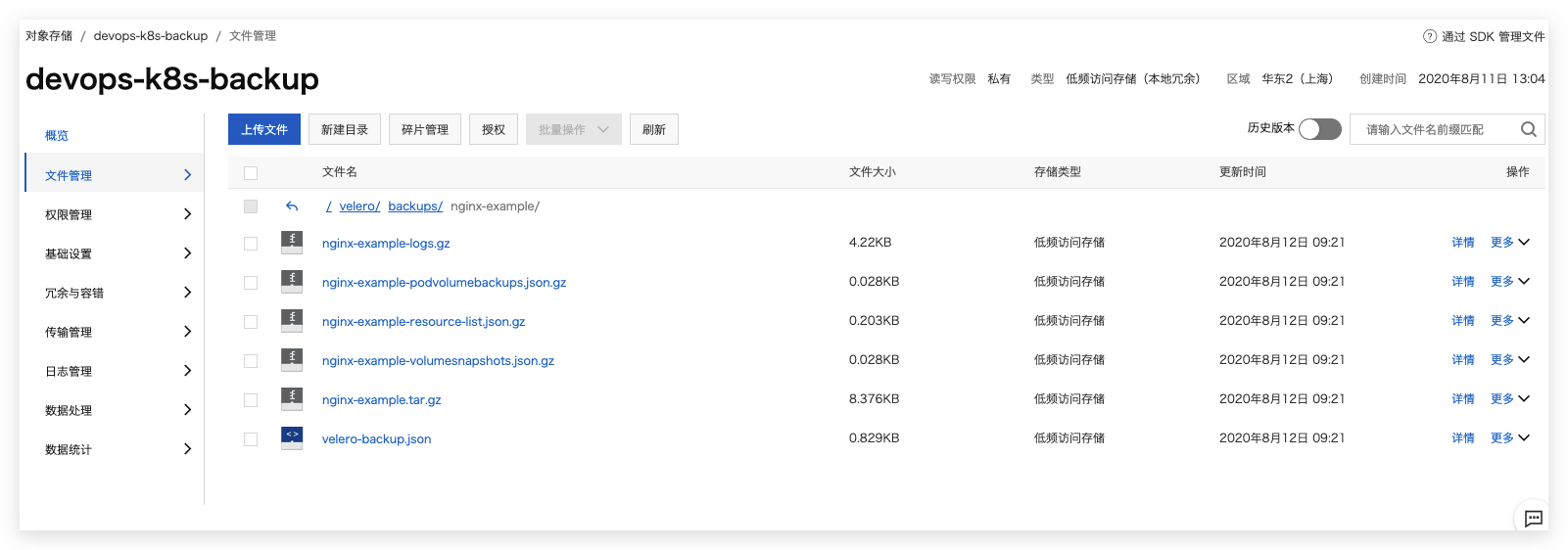Kubernetes备份恢复之velero实战
一 背景
Kubernetes 集群备份是一大难点。虽然可以通过etcd来进行备份来实现K8S集群备份,但是这种备份很难恢复单个 Namespace。
对于K8s集群数据的备份和恢复,以及复制当前集群数据到其他集群等都非常方便。可以在两个集群间克隆应用和命名空间,来创建一个临时性的开发环境。
二 Velero概述
2.1 什么是Velero
Velero 是一个云原生的灾难恢复和迁移工具,它本身也是开源的, 采用 Go 语言编写,可以安全的备份、恢复和迁移Kubernetes集群资源和持久卷。
Velero 是西班牙语,意思是帆船,非常符合 Kubernetes 社区的命名风格。Velero 的开发公司 Heptio,之前已被 VMware 收购,其创始人2014就职于Google,当时被认为是 Kubernetes 核心成员。
Velero 是一种云原生的Kubernetes优化方法,支持标准的K8S集群,既可以是私有云平台也可以是公有云。除了灾备之外它还能做资源移转,支持把容器应用从一个集群迁移到另一个集群。
Heptio Velero ( 以前的名字为 ARK) 是一款用于 Kubernetes 集群资源和持久存储卷(PV)的备份、迁移以及灾难恢复等的开源工具。
使用velero可以对集群进行备份和恢复,降低集群DR造成的影响。velero的基本原理就是将集群的数据备份到对象存储中,在恢复的时候将数据从对象存储中拉取下来。可以从官方文档查看可接收的对象存储,本地存储可以使用Minio。下面演示使用velero将openstack上的openshift集群备份恢复到阿里云的openshift上。
2.2 Velero工作流程
2.2.1 流程图


2.2.2 备份过程
- 本地
Velero客户端发送备份指令。 Kubernetes集群内就会创建一个Backup对象。BackupController监测Backup对象并开始备份过程。BackupController会向API Server查询相关数据。BackupController将查询到的数据备份到远端的对象存储。
2.3 Velero的特性
Velero 目前包含以下特性:
- 支持
Kubernetes集群数据备份和恢复 - 支持复制当前
Kubernetes集群的资源到其它Kubernetes集群 - 支持复制生产环境到开发以及测试环境
2.4 Velero组建
Velero 组件一共分两部分,分别是服务端和客户端。
- 服务端:运行在你
Kubernetes的集群中 - 客户端:是一些运行在本地的命令行的工具,需要已配置好
kubectl及集群kubeconfig的机器上
2.5 支持备份存储
- AWS S3 以及兼容 S3 的存储,比如:Minio
- Azure BloB 存储
- Google Cloud 存储
- Aliyun OSS 存储(https://github.com/AliyunContainerService/velero-plugin)
> 项目地址:https://github.com/heptio/velero
2.6 适应场景
灾备场景:提供备份恢复k8s集群的能力迁移场景:提供拷贝集群资源到其他集群的能力(复制同步开发,测试,生产环境的集群配置,简化环境配置)
2.7 与etcd的区别
与 Etcd 备份相比,直接备份 Etcd 是将集群的全部资源备份起来。而 Velero 就是可以对 Kubernetes 集群内对象级别进行备份。除了对 Kubernetes 集群进行整体备份外,Velero 还可以通过对 Type、Namespace、Label 等对象进行分类备份或者恢复。
> 注意: 备份过程中创建的对象是不会被备份的。
三 备份过程
Velero 在 Kubernetes 集群中创建了很多 CRD 以及相关的控制器,进行备份恢复等操作实质上是对相关 CRD 的操作。
# Velero 在 Kubernetes 集群中创建的 CRD
$ kubectl -n velero get crds -l component=velero
NAME CREATED AT
backups.velero.io 2019-08-28T03:19:56Z
backupstoragelocations.velero.io 2019-08-28T03:19:56Z
deletebackuprequests.velero.io 2019-08-28T03:19:56Z
downloadrequests.velero.io 2019-08-28T03:19:56Z
podvolumebackups.velero.io 2019-08-28T03:19:56Z
podvolumerestores.velero.io 2019-08-28T03:19:56Z
resticrepositories.velero.io 2019-08-28T03:19:56Z
restores.velero.io 2019-08-28T03:19:56Z
schedules.velero.io 2019-08-28T03:19:56Z
serverstatusrequests.velero.io 2019-08-28T03:19:56Z
volumesnapshotlocations.velero.io 2019-08-28T03:19:56Z
3.1 保障数据一致性
对象存储的数据是唯一的数据源,也就是说 Kubernetes 集群内的控制器会检查远程的 OSS 存储,发现有备份就会在集群内创建相关 CRD 。如果发现远端存储没有当前集群内的 CRD 所关联的存储数据,那么就会删除当前集群内的 CRD。
3.2 支持的后端存储
Velero 支持两种关于后端存储的 CRD,分别是 BackupStorageLocation 和 VolumeSnapshotLocation。
3.2.1 BackupStorageLocation
BackupStorageLocation 主要用来定义 Kubernetes 集群资源的数据存放位置,也就是集群对象数据,不是 PVC 的数据。主要支持的后端存储是 S3 兼容的存储,比如:Mino 和阿里云 OSS 等。
3.2.1.1 Minio
apiVersion: velero.io/v1
kind: BackupStorageLocation
metadata:
name: default
namespace: velero
spec:
# 只有 aws gcp azure
provider: aws
# 存储主要配置
objectStorage:
# bucket 的名称
bucket: myBucket
# bucket内的
prefix: backup
# 不同的 provider 不同的配置
config:
#bucket地区
region: us-west-2
# s3认证信息
profile: "default"
# 使用 Minio 的时候加上,默认为 false
# AWS 的 S3 可以支持两种 Url Bucket URL
# 1 Path style URL: http://s3endpoint/BUCKET
# 2 Virtual-hosted style URL: http://oss-cn-beijing.s3endpoint 将 Bucker Name 放到了 Host Header中
# 3 阿里云仅仅支持 Virtual hosted 如果下面写上 true, 阿里云 OSS 会报错 403
s3ForcePathStyle: "false"
# s3的地址,格式为 http://minio:9000
s3Url: http://minio:9000
3.2.1.2 阿里OSS
apiVersion: velero.io/v1
kind: BackupStorageLocation
metadata:
labels:
component: velero
name: default
namespace: velero
spec:
config:
region: oss-cn-beijing
s3Url: http://oss-cn-beijing.aliyuncs.com
s3ForcePathStyle: "false"
objectStorage:
bucket: build-jenkins
prefix: ""
provider: aws
3.2.2 VolumeSnapshotLocation
VolumeSnapshotLocation 主要用来给 PV 做快照,需要云提供商提供插件。阿里云已经提供了插件,这个需要使用 CSI 等存储机制。你也可以使用专门的备份工具 Restic,把 PV 数据备份到阿里云 OSS 中去(安装时需要自定义选项)。
# 安装时需要自定义选项
--use-restic
# 这里我们存储 PV 使用的是 OSS 也就是 BackupStorageLocation,因此不用创建 VolumeSnapshotLocation 对象
--use-volume-snapshots=false
Restic 是一款 GO 语言开发的数据加密备份工具,顾名思义,可以将本地数据加密后传输到指定的仓库。支持的仓库有 Local、SFTP、Aws S3、Minio、OpenStack Swift、Backblaze B2、Azure BS、Google Cloud storage、Rest Server。
项目地址:https://github.com/restic/restic
四 实践velero备份minio
4.1 环境要求
- kubernetes >1.7;
4.2 部署velero
4.2.1 下载velero
wget https://github.com/vmware-tanzu/velero/releases/download/v1.4.2/velero-v1.4.2-linux-amd64.tar.gz
tar -zxvf velero-v1.4.2-linux-amd64.tar.gz
4.2.2 安装minio
cd velero-v1.4.2-linux-amd64
[root@master velero-v1.4.2-linux-amd64]# cat examples/minio/00-minio-deployment.yaml
---
apiVersion: v1
kind: Namespace
metadata:
name: velero
---
apiVersion: apps/v1
kind: Deployment
metadata:
namespace: velero
name: minio
labels:
component: minio
spec:
strategy:
type: Recreate
selector:
matchLabels:
component: minio
template:
metadata:
labels:
component: minio
spec:
volumes:
- name: storage
emptyDir: {}
- name: config
emptyDir: {}
containers:
- name: minio
image: minio/minio:latest
imagePullPolicy: IfNotPresent
args:
- server
- /storage
- --config-dir=/config
env:
- name: MINIO_ACCESS_KEY
value: "minio"
- name: MINIO_SECRET_KEY
value: "minio123"
ports:
- containerPort: 9000
volumeMounts:
- name: storage
mountPath: "/storage"
- name: config
mountPath: "/config"
---
apiVersion: v1
kind: Service
metadata:
namespace: velero
name: minio
labels:
component: minio
spec:
# ClusterIP is recommended for production environments.
# Change to NodePort if needed per documentation,
# but only if you run Minio in a test/trial environment, for example with Minikube.
type: ClusterIP
ports:
- port: 9000
targetPort: 9000
protocol: TCP
selector:
component: minio
---
apiVersion: batch/v1
kind: Job
metadata:
namespace: velero
name: minio-setup
labels:
component: minio
spec:
template:
metadata:
name: minio-setup
spec:
restartPolicy: OnFailure
volumes:
- name: config
emptyDir: {}
containers:
- name: mc
image: minio/mc:latest
imagePullPolicy: IfNotPresent
command:
- /bin/sh
- -c
- "mc --config-dir=/config config host add velero http://minio:9000 minio minio123 && mc --config-dir=/config mb -p velero/velero"
volumeMounts:
- name: config
mountPath: "/config"
由上面资源清淡我们可以看到,在安装minio的时候
MINIO_ACCESS_KEY:minio
MINIO_SECRET_KEY:minio123
service的地址为:http://minio:9000,类型为ClusterIP,我们可以映射为NodePort查看
最后执行了一个job来创建一个名称为:velero/velero的bucket,在创建的时候适应了。
- 安装
[root@master velero-v1.4.2-linux-amd64]# kubectl apply -f examples/minio/00-minio-deployment.yaml
namespace/velero created
deployment.apps/minio created
service/minio created
job.batch/minio-setup created
[root@master velero-v1.4.2-linux-amd64]# kubectl get all -n velero
NAME READY STATUS RESTARTS AGE
pod/minio-fdd868c5-xv52k 0/1 ContainerCreating 0 14s
pod/minio-setup-hktjb 0/1 ContainerCreating 0 14s
NAME TYPE CLUSTER-IP EXTERNAL-IP PORT(S) AGE
service/minio ClusterIP 10.233.39.204 9000/TCP 14s
NAME READY UP-TO-DATE AVAILABLE AGE
deployment.apps/minio 0/1 1 0 14s
NAME DESIRED CURRENT READY AGE
replicaset.apps/minio-fdd868c5 1 1 0 14s
NAME COMPLETIONS DURATION AGE
job.batch/minio-setup 0/1 14s 14s
待服务都已经启动完毕,可以登录minio查看velero/velero的bucket是否创建成功。
修改svc,登录查看
[root@master velero-v1.4.2-linux-amd64]# kubectl get svc -n velero minio
NAME TYPE CLUSTER-IP EXTERNAL-IP PORT(S) AGE
minio NodePort 10.233.39.204 9000:30401/TCP 2m26s

4.2.3 安装velero
4.2.3.1 创建密钥
安装velero需要创建能正常登录minio的密钥
cat > credentials-velero <)
# 对 PV 创建快照
--snapshot-volumes optionalBool[=true] take snapshots of PersistentVolumes as part of the backup
# 指定备份的位置
--storage-location string location in which to store the backup
# 备份数据多久删掉
--ttl duration how long before the backup can be garbage collected (default 720h0m0s)
# 指定快照的位置,也就是哪一个公有云驱动
--volume-snapshot-locations strings list of locations (at most one per provider) where volume snapshots should be stored
4.4 测试
velero非常的人性化,在安装包中已经为我们准备好了测试demo,我们可以利用测试demo来进行测试验证。
4.4.1 创建测试应用
[root@master velero-v1.4.2-linux-amd64]# kubectl apply -f examples/nginx-app/base.yaml
namespace/nginx-example created
deployment.apps/nginx-deployment created
service/my-nginx created
[root@master velero-v1.4.2-linux-amd64]# kubectl get all -n nginx-example
NAME READY STATUS RESTARTS AGE
pod/nginx-deployment-f4769bfdf-8jrsz 0/1 ContainerCreating 0 12s
pod/nginx-deployment-f4769bfdf-sqfp4 0/1 ContainerCreating 0 12s
NAME TYPE CLUSTER-IP EXTERNAL-IP PORT(S) AGE
service/my-nginx LoadBalancer 10.233.10.49 80:32401/TCP 13s
NAME READY UP-TO-DATE AVAILABLE AGE
deployment.apps/nginx-deployment 0/2 2 0 14s
NAME DESIRED CURRENT READY AGE
replicaset.apps/nginx-deployment-f4769bfdf 2 2 0 14s
4.4.2 执行备份
[root@master velero-v1.4.2-linux-amd64]# velero backup create nginx-backup --include-namespaces nginx-example
Backup request "nginx-backup" submitted successfully.
Run `velero backup describe nginx-backup` or `velero backup logs nginx-backup` for more details.
[root@master velero-v1.4.2-linux-amd64]# velero backup describe nginx-backup
Name: nginx-backup
Namespace: velero
Labels: velero.io/storage-location=default
Annotations: velero.io/source-cluster-k8s-gitversion=v1.15.5
velero.io/source-cluster-k8s-major-version=1
velero.io/source-cluster-k8s-minor-version=1
Phase: Completed
Errors: 0
Warnings: 0
Namespaces:
Included: nginx-example
Excluded:
Resources:
Included: *
Excluded:
Cluster-scoped: auto
Label selector:
Storage Location: default
Velero-Native Snapshot PVs: auto
TTL: 720h0m0s
Hooks:
Backup Format Version: 1
Started: 2020-07-21 19:12:16 +0800 CST
Completed: 2020-07-21 19:12:24 +0800 CST
Expiration: 2020-08-20 19:12:16 +0800 CST
Total items to be backed up: 23
Items backed up: 23
Velero-Native Snapshots:
4.4.3 查看备份信息
- 登录minio查看备份信息


- 查看目录结构

4.4.4 进行恢复测试
4.4.4.1 删除nginx服务
[root@master velero-v1.4.2-linux-amd64]# kubectl delete -f examples/nginx-app/base.yaml
namespace "nginx-example" deleted
deployment.apps "nginx-deployment" deleted
service "my-nginx" deleted
4.4.4.2 恢复nginx服务
[root@master velero-v1.4.2-linux-amd64]# velero restore create --from-backup nginx-backup --wait
Restore request "nginx-backup-20200722134728" submitted successfully.
Waiting for restore to complete. You may safely press ctrl-c to stop waiting - your restore will continue in the background.
Restore completed with status: Completed. You may check for more information using the commands `velero restore describe nginx-backup-20200722134728` and `velero restore logs nginx-backup-20200722134728`.
[root@master velero-v1.4.2-linux-amd64]# kubectl get pods -n nginx-example
NAME READY STATUS RESTARTS AGE
nginx-deployment-f4769bfdf-8jrsz 1/1 Running 0 7s
nginx-deployment-f4769bfdf-sqfp4 1/1 Running 0 7s
注意:velero restore 恢复不会覆盖已有的资源,只恢复当前集群中不存在的资源。已有的资源不会回滚到之前的版本,如需要回滚,需在restore之前提前删除现有的资源。

五 实践velero备份OSS
本实例实践如何在阿里云容器服务 ACK 使用 Velero 完成备份和迁移。
ACK 插件地址:https://github.com/AliyunContainerService/velero-plugin
5.1 创建OSS bucket
由于为低频存储,类型为低频访问存储,权限为私有

- 创建bucket,在配置velero 的prefix中用到

- 配置对象存储生命周期


5.2 创建阿里云RAM用户
在此最好需要创建一个阿里云RAM用户,用于操作OSS以及ACK资源,用于权限分类,提升安全性。
5.2.1 新建权限策略

策略内容:
{
"Version": "1",
"Statement": [
{
"Action": [
"ecs:DescribeSnapshots",
"ecs:CreateSnapshot",
"ecs:DeleteSnapshot",
"ecs:DescribeDisks",
"ecs:CreateDisk",
"ecs:Addtags",
"oss:PutObject",
"oss:GetObject",
"oss:DeleteObject",
"oss:GetBucket",
"oss:ListObjects"
],
"Resource": [
"*"
],
"Effect": "Allow"
}
]
}
5.2.2 新建用户
在新建用户的时候要选择 编程访问,来获取 AccessKeyID 和 AccessKeySecret,这里请创建一个新用于用于备份,不要使用老用户的 AK 和 AS。

5.3 部署服务端
5.3.1 拉取velero插件
git clone https://github.com/AliyunContainerService/velero-plugin
5.3.2 配置参数
- 修改
install/credentials-velero文件,将新建用户中获得的AccessKeyID和AccessKeySecret填入。

ALIBABA_CLOUD_ACCESS_KEY_ID=
ALIBABA_CLOUD_ACCESS_KEY_SECRET=
1.创建 velero 命名空间 和 阿里云 secret
# 创建 velero 命名空间
$ kubectl create namespace velero
# 创建阿里云 secret
$ kubectl create secret generic cloud-credentials --namespace velero --from-file cloud=install/credentials-velero
2.替换crd中对象存储信息,部署crd和velero
# OSS Bucket 名称
$ BUCKET=devops-k8s-backup
# OSS 所在可用区
$ REGION=cn-shanghai
# bucket 名字
$ prefix=velero
# 部署 velero CRD
$ kubectl apply -f install/00-crds.yaml
# 替换 OSS Bucket 与 OSS 所在可用区
$ sed -i "s##$BUCKET#" install/01-velero.yaml
$ sed -i "s##$REGION#" install/01-velero.yaml
# 替换bucket 中名字prifix
# 查看差异
[root@master velero-plugin]# git diff install/01-velero.yaml
diff --git a/install/01-velero.yaml b/install/01-velero.yaml
index 5669860..7dd4c5a 100644
--- a/install/01-velero.yaml
+++ b/install/01-velero.yaml
@@ -31,10 +31,10 @@ metadata:
namespace: velero
spec:
config:
- region:
+ region: cn-shanghai
objectStorage:
- bucket:
- prefix: ""
+ bucket: devops-k8s-backup
+ prefix: "velero"
provider: alibabacloud
---
@@ -47,7 +47,7 @@ metadata:
namespace: velero
spec:
config:
- region:
+ region: cn-shanghai
provider: alibabacloud
---
# 创建认证secret
kubectl create namespace velero
# 部署velero
$ kubectl apply -f install/
# 查看velero
$ kubectl get pods -n velero
[root@master velero-plugin]# kubectl get pods -n velero
NAME READY STATUS RESTARTS AGE
velero-fcc8d77b8-569jz 1/1 Running 0 45s
# 查看位置
[root@master velero-plugin]# velero get backup-locations
NAME PROVIDER BUCKET/PREFIX ACCESS MODE
default alibabacloud devops-k8s-backup/velero ReadWrite
5.4 备份恢复
5.4.1 备份
$ velero backup create nginx-example --include-namespaces nginx-example

5.4.2 恢复
velero restore create --from-backup nginx-example
5.4.3 周期性任务
# Create a backup every 6 hours
velero create schedule NAME --schedule="0 */6 * * *"
# Create a backup every 6 hours with the @every notation
velero create schedule NAME --schedule="@every 6h"
# Create a daily backup of the web namespace
velero create schedule NAME --schedule="@every 24h" --include-namespaces web
# Create a weekly backup, each living for 90 days (2160 hours)
velero create schedule NAME --schedule="@every 168h" --ttl 2160h0m0s
# 每日对anchnet-devops-dev/anchnet-devops-test/anchnet-devops-prod/xxxxx-devops-common-test 名称空间进行备份
velero create schedule anchnet-devops-dev --schedule="@every 24h" --include-namespaces xxxxx-devops-dev
velero create schedule anchnet-devops-test --schedule="@every 24h" --include-namespaces xxxxx-devops-test
velero create schedule anchnet-devops-prod --schedule="@every 24h" --include-namespaces xxxxx-devops-prod
velero create schedule anchnet-devops-common-test --schedule="@every 24h" --include-namespaces xxxxx-devops-common-test


六 注意事项
-
在velero备份的时候,备份过程中创建的对象是不会被备份的。
-
velero restore恢复不会覆盖已有的资源,只恢复当前集群中不存在的资源。已有的资源不会回滚到之前的版本,如需要回滚,需在restore之前提前删除现有的资源。 -
后期可以讲velero作为一个crontjob来运行,定期备份数据。
-
在高版本1.16.x中,报错
error: unable to recognize "filebeat.yml": no matches for kind "DaemonSet" in version "extensions/v1beta1",将yml配置文件内的api接口修改为 apps/v1 ,导致原因为之间使用的kubernetes 版本是1.14.x版本,1.16.x 版本放弃部分API支持!
参考资料
- https://www.hi-linux.com/posts/60858.html
- https://bingohuang.com/heptio-velero-intro/
- https://velero.io/
- https://github.com/heptio/velero
- https://github.com/heptio/velero-community
- https://www.cncf.io/webinars/kubernetes-backup-and-migration-strategies-using-project-velero/
- https://developer.aliyun.com/article/705007
- https://github.com/AliyunContainerService/velero-plugin
- https://developer.aliyun.com/article/726863
- https://cloud.tencent.com/developer/article/1653649
- 点赞
- 收藏
- 关注作者


评论(0)